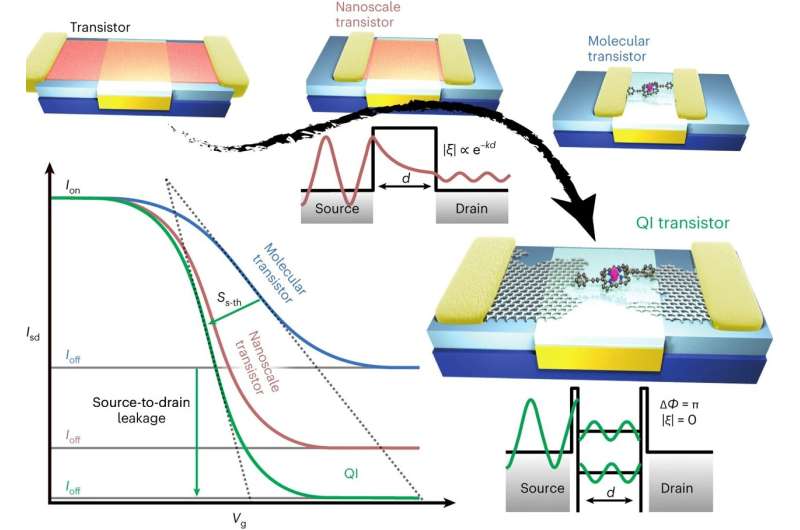This article has been reviewed according to Science X's editorial process and policies. Editors have highlighted the following attributes while ensuring the content's credibility:
fact-checked
peer-reviewed publication
trusted source
proofread
Quantum interference could lead to smaller, faster, and more energy-efficient transistors

An international team of researchers from Queen Mary University of London, the University of Oxford, Lancaster University, and the University of Waterloo have developed a new single-molecule transistor that uses quantum interference to control the flow of electrons. The transistor, which is described in a paper published in the Nature Nanotechnology, opens new possibilities for using quantum effects in electronic devices.
Transistors are the basic building blocks of modern electronics. They are used to amplify and switch electrical signals, and they are essential for everything from smartphones to spaceships. However, the traditional method of making transistors, which involves etching silicon into tiny channels, is reaching its limits.
As transistors get smaller, they become increasingly inefficient and susceptible to errors, as electrons can leak through the device even when it is supposed to be switched off, by a process known as quantum tunneling. Researchers are exploring new types of switching mechanisms that can be used with different materials to remove this effect.
In the nanoscale structures that Professor Jan Mol, Dr. James Thomas, and their group study at Queen Mary's School of Physical and Chemical Sciences, quantum mechanical effects dominate, and electrons behave as waves rather than particles. Taking advantage of these quantum effects, the researchers built a new transistor.
The transistor's conductive channel is a single zinc porphyrin, a molecule that can conduct electricity. The porphyrin is sandwiched between two graphene electrodes, and when a voltage is applied to the electrodes, electron flow through the molecule can be controlled using quantum interference.
Interference is a phenomenon that occurs when two waves interact with each other and either cancel each other out (destructive interference) or reinforce each other (constructive interference). In the new transistor's case, researchers switched the transistor on and off by controlling whether the electrons interfere constructively (on) or destructively (off) as they flow through the zinc porphyrin molecule.
The researchers found that the new transistor has a very high on/off ratio, meaning that it can be turned on and off very precisely. Destructive quantum interference plays a crucial role in this by eliminating the leaky electron flow from quantum tunneling through the transistor when it is supposed to be switched off.
They also found that the transistor is very stable. Previous transistors made from a single molecule have only been able to demonstrate a handful of switching cycles. However, this device can be operated for hundreds of thousands of cycles without breaking down.
"Quantum interference is a powerful phenomenon that has the potential to be used in a wide variety of electronics applications," said lead author Dr. James Thomas, Lecturer in Quantum Technologies at Queen Mary. "We believe that our work is a significant step towards realizing this potential."
"Our results show that quantum interference can be used to control the flow of electrons in transistors and that this can be done in a way that is both efficient and reliable," said co-author Professor Jan Mol. "This could lead to the development of new types of transistors that are smaller, faster, and more energy-efficient than current devices."
The researchers also found that the quantum interference effects could be used to improve the transistor's subthreshold swing, which is a measure of how sensitive the transistor is to changes in the gate voltage. The lower the subthreshold swing, the more efficient the transistor is.
The researchers' transistors had a subthreshold swing of 140 mV/dec, which is better than subthreshold swings reported for other single-molecule transistors and comparable to larger devices made from materials such as carbon nanotubes.
The research is still in its initial stages, but the researchers are optimistic that the new transistor could be used to create a new generation of electronic devices. These devices could be used in a variety of applications, starting from computers and smartphones and ending with medical devices.
More information: Zhixin Chen et al, Quantum interference enhances the performance of single-molecule transistors, Nature Nanotechnology (2024). DOI: 10.1038/s41565-024-01633-1
Journal information: Nature Nanotechnology
Provided by Queen Mary, University of London



















